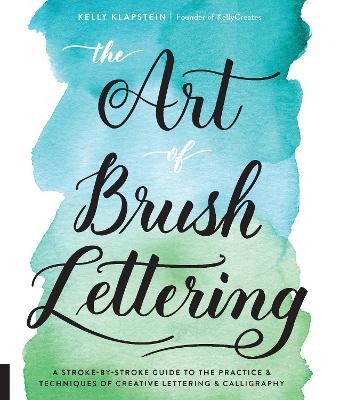Reviewed by annieb123 on
I love calligraphy books. There is something very relaxing and meditative about sitting quietly and finding a thoughtful zone and seeing a piece come together on the paper. Even (especially?) the practice that goes before getting comfortable with a new technique is a meditative process and valuable for the quiet time and sense of mastery it provides.
The author of The Art of Brush Lettering talks in her introduction about the mindfulness and relaxation of daily practice and the satisfaction that comes from making progress with the lettering techniques she presents in this book. The writing style is calm and inspires confidence even with beginners.
The book starts off with an introduction of what brush lettering is, what style of lettering this particular book covers, along with photographs showing the materials and some different styles of pens and how they work and what the strengths and differences are. How to choose and care for your tools is important and she does a decent job of explaining how to lengthen the life of your pens, what kind of paper to choose and how to make/print practice sheets for lettering.
Our bodies are our most important tools, and the author uses several pages with photographs explaining ergonomic working positions, relaxation, posture and combatting fatigue including exercises for relaxing muscles in the shoulders, neck, hands, arms and fingers.
She rounds out the introductory chapters with a discussion of papers and other supplies (rough paper vs. smooth and how it impacts the durability of the brush pens, etc). The introductory chapters comprise roughly 20% of the total content.
The next chapters are set up in a primer format. Pages of strokes and parts of letters/spacing/words which will make up the tools with which the artist creates. These chapters begin simply and develop in complexity and completeness as they progress. These chapters form roughly 30% of the total content and are thorough, but not intimidating. They include clear, concise diagrams and practice examples.
The last half of the book is given over to elaborating on the basics. There are chapters on freeform lettering and special techniques to make dimensional, highlighted or otherwise embellish the basic letters covered in the primer.
The end includes a complete set of tracing and practice templates with examples and good photographs to help the artist along.
There are no links at the end of the book, but there is a simple index included.
Lovely and relaxing prose, beautiful clear photography and good, well explained practice sheets. A worthwhile addition to the calligrapher's library.
Four stars
Disclosure: I received an ARC at no cost from the author/publisher.
Reading updates
- Started reading
- Finished reading
- 10 November, 2017: Reviewed
